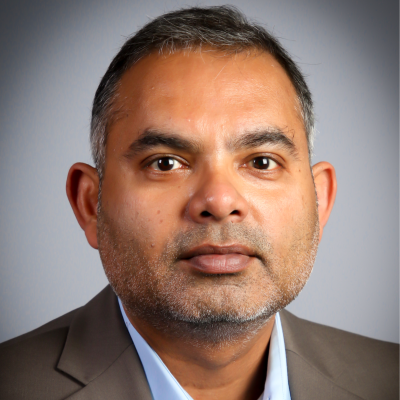Main Conference Day 2 - February 25, 2026
View the schedule for Day two of the AI in Energy Summit, Houston's leading energy conference and learn how to augment your workforce, maximize asset performance and power intelligent operations
7:00 am - 8:00 am
Registration and Networking Breakfast
8:00 am - 8:10 am
Chair’s Opening Address
8:10 am - 8:40 am
Keynote Case Study: Building the Future of Energy with AI at AES
Erin Boyd -
Chief Digital Commercial Transformation Officer,
AES
As AES shifts from a global digital model to a hub-and-spoke structure, it’s reimagining how innovation scales across the enterprise. At the heart of this transformation is a new Digital Center of Excellence, led by Erin, who is tasked with building future-ready platforms that not only keep pace with AI’s rapid evolution but also empower teams to explore what’s possible. With a bold mandate to triple energy capacity without increasing headcount, AES is betting on AI to drive both cultural and operational transformation.
- Discover how AES is empowering creativity at scale by building an ecosystem that enables teams across all business units to experiment and innovate with AI tools, driving individual productivity and enterprise-wide impact
- Explore how platform-agnostic experimentation allows AES to test a wide range of AI tools to find the best fit for specific use cases, while managing the complexity of evaluating and integrating rapidly evolving technologies
- Learn how AES is scaling with guardrails by defining clear parameters for enterprise-wide deployment of successfully piloted tools, balancing innovation with the need for robust data governance and access control
- Understand how partnering for agility enables AES to accelerate AI adoption through strategic collaborations with startups, while addressing the challenge of ensuring long-term value and seamless integration in a fast-moving market
8:40 am - 9:10 am
No Surprises: Using Machine Learning to Predict, Prioritize, and Prevent Equipment Failures
Predictive maintenance is no longer just about forecasting failures; it’s about making smarter operational decisions in real time. In this session, we will showcase how machine learning helps energy operators move from reactive to proactive maintenance strategies. By combining historical failure data, real-time sensor inputs, and operational context, machine learning enables teams to prioritize interventions, reduce unnecessary work, and extend asset life, all without overhauling existing infrastructure.
9:10 am - 9:40 am
Case Study: Engineering the Digital Twin: AI and Data Strategy for Asset Intelligence
Marcus Johansson -
Director, Technology Services, Application Delivery,
Xcel Energy
Currently in the early stages of a 10-year digital transformation journey, Xcel Energy is building the foundation for a full digital twin of its operations. With a focus on real-time data, predictive modelling, and a robust data fabric, the team is working toward a future where decisions are automated, insights are proactive, and systems are seamlessly integrated. In this session, Marcus will share a clear view of where the organization stands today, the strategic next steps ahead, and the key considerations shaping their journey toward a fully realized digital twin.
- Gain insight into the foundational use case that launched the transformation, including how real-time smart meter data is used with predictive analytics to assess transformer health and EV impact, laying the groundwork for broader integration into advanced systems for proactive planning
- Learn how value stream mapping and regulatory alignment are used to ensure each AI use case delivers measurable business impact, with vendor partnerships structured to support both compliance and long-term value.
- Review the hybrid build-buy model supporting operational readiness, where internal and external resources are scaled, transitioned, and trained using readiness checklists to ensure smooth integration and long-term capability development
- Explore the long-term vision for a digital twin of operations, where real-time monitoring of assets is paired with probabilistic, deterministic, and fragility models to enable smarter decision-making, with distribution targeted within five years and transmission by year ten
9:40 am - 10:30 am
Lightning Tech Talks
Join us for a dynamic round of innovative AI applications! Each session, lasting 10 minutes, will showcase cutting-edge innovations designed to enhance visibility, productivity, and efficiency. Don't miss this opportunity to explore the latest advancements and see how they can transform your operations.
10:30 am - 11:00 am
Morning Networking Break
Scalable AI
11:00 am - 11:30 am Panel Discussion: From Proof of Concept to Scale: Success Factors and Execution Strategies Sandeep Mukherjee - Petrophysics Advisor, ApacheMeenakshi Mishra - Principal Data Scientist, ExxonMobil
Shuxing Cheng - Principal Research Data Scientist, Chevron
Eyob Gebremariam - Senior AI Delivery Manager, Duke Energy
While the potential of AI is no longer in question, the journey from POC to scalable, enterprise-grade deployment remains complex. A key challenge lies in the disconnect between technology leaders and the operational realities of energy environments, leading to unrealistic expectations around the pace and complexity of scaling AI. In this session we will review the end-to-end lifecycle of AI deployment, from initial PoC, to platform-based implementation within business units and ultimately enterprise-wide integration, shining a spotlight on common pitfalls, success factors and execution strategies.
- Examining how data architecture and standardization can help structure both operational and historical data to ensure AI models interact effectively and reliably at scale
- Considering the role of human-centered design and user interfaces in driving adoption of AI-powered tools, making complex technologies more intuitive, accessible, and impactful for end users
- Real-world use cases that illustrate different implementation strategies by AI type, with a spotlight on how traditional machine learning models and generative AI require distinct approaches to scaling and integration
Scalable AI
11:30 am - 12:00 pm Case Study: AI-Driven Asset and Workforce Intelligence for Scalable Value at Capital Power John A. Shannon - Vice President, Data Science and Insights, Capital PowerAs the fifth-largest independent power producer in North America, Capital Power is navigating a bold transformation, expanding its thermal portfolio with a $2.1B acquisition in PJM, reshaping its workforce and building a future-ready AI strategy. At the heart of this shift is a pragmatic, use-case-first approach to AI innovation that prioritizes flexibility, measurable business value, and deep user engagement. Rather than betting on individual tools, Capital Power is building a composable architecture that allows the best models to be orchestrated in real time ensuring long-term enterprise impact.
- Discover how Capital Power identifies high-impact AI use cases, such-as predictive maintenance, by starting with operational pain points and defining success through clear, business-aligned metrics
- Explore how generative AI is being used to scale workforce capabilities following the reduction in staff to enable smarter regulatory oversight, environmental compliance, and market visibility across a diverse asset base
- Learn how Capital Power is future-proofing its AI investments by building flexible, model-agnostic architectures that allow for plug-and-play integration of emerging technologies
- Understand why deep user engagement, from ideation to implementation, is the make-or-break factor in AI adoption, and how Capital Power see’s senior leadership as coaches for transformation
Scalable AI
12:00 pm - 12:30 pm Case Study: Computer Vision in Action: Scaling AI for Grid Asset Intelligence and Operational Efficiency Zefan Tang - Senior Data Scientist, Eversource EnergyAs utilities modernize their infrastructure, the ability to extract actionable insights from visual and operational data is becoming a game-changer. In this session, Eversource Energy, New England’s largest utility, shares how they are deploying computer vision and machine learning to assist asset inspection, predictive maintenance, and internal engineering workflows for transmission and distribution systems.
From drone-based inspections of transmission lines to dashcam-enabled video analysis of distribution infrastructure, learn how Eversource is accelerating anomaly detection and reducing manual review time. Key challenges such as data collection, model retraining, and cross-team deployment will be addressed, offering practical insights into building scalable, secure AI pipelines that deliver real operational value.
Operational Optimization
11:00 am - 11:30 am Building Trust at the Speed of AI: Skills, Standards & Storytelling Jennifer Rogers - Senior Director of Education and Executive Officer, Learning Technology Standard, AMPP (Association for Materials Protection and Performance) and IEEE (Institute of Electrical and Electronics Engineers)The race for AI adoption is well and truly on, but will slow and steady win the race? The collective consensus is whilst speed to innovation is key to unlocking safer and more productive operations, building trust and transparency with the workforce is the engine for AI-driven change. In this session, Jennifer will explore how to bridge the AI skills gap, build competency frameworks fit for the ever-evolving landscape and craft a compelling narrative that empowers, not alienates, your people.
- With the fast-paced nature of AI innovation, explore how skill acceleration enables the workforce to interact with evolving AI technologies safely, confidently, and responsibly ensuring adoption is both rapid and secure
- Learn how the IEEE’s competency framework is rethinking digital skill models to promote agility, and how their Open-Source Initiative has helped build trust and transparency by harnessing collective knowledge across the workforce
- Gain key learnings from global lessons in AI readiness, drawing on scalable and inclusive skills strategies from initiatives such as the EU’s Horizon projects and World Bank programs
- Explore how reframing the AI narrative around augmentation, not replacement, can shift perceptions from fear to opportunity by highlighting how AI enhances human roles, improves operational safety, increases efficiency, and empowers previously excluded segments of the workforce

Jennifer Rogers
Senior Director of Education and Executive Officer, Learning Technology StandardAMPP (Association for Materials Protection and Performance) and IEEE (Institute of Electrical and Electronics Engineers)
Operational Optimization
11:30 am - 12:00 pm Mapping the Field: Building Data Foundations Across Multi-Operator Assets Raymond Mitten - Vice President, Advanced Digital Technologies, Business Transformation, Imperative Chemical PartnersIn this session, we explore the challenges and opportunities of applying AI in a multi-operator environment, where data from thousands of operators must be securely separated, yet intelligently connected. Raymond will share how his team is building a cloud-based data lake and partnership ecosystem to support scalable, secure, and actionable insights across regions like the Permian.

Raymond Mitten
Vice President, Advanced Digital Technologies, Business TransformationImperative Chemical Partners
Operational Optimization
12:00 pm - 12:30 pm Case Study: Optimizing Production in End-of-Life Wells with Machine Learning at Ovintiv Yousef Hamedi Shokrlu - Advisor, Data Science, OvintivAs wells reach the end of their productive life, maximizing output becomes increasingly complex, especially for artificial lift systems like plunger lift and gas-assisted plunger wells. This session explores how machine learning is being used to optimize production by identifying the ideal shut in and flow times, gas injection rates, and equipment configurations. After a successful pilot, Ovintiv is moving toward full automation, allowing models to recommend optimal settings and prioritize wells for intervention.
With limited engineering resources and hundreds of wells to manage, this data-driven approach helps surface underperforming assets and simulate production outcomes under various scenarios. Yousef will also explore the challenges of working with sparse data, the trade-offs between global and well-specific models, and the importance of communicating model reliability and limitations to operational teams.
12:30 pm - 1:20 pm
Networking Lunch
1:20 pm - 1:50 pm
Panel Discussion: Building Better Workers: Developing an AI Workforce Strategy
Molly Determan -
President,
Energy Workforce & Technology Council
Kiela Abbott-Robinson - Director Strategic Initiatives, NextEra Energy
Prerit Shah - Product Manager - AI Platforms, MLOps and Data Science, Equinor
Preparing your organization for AI is where change management and technology mix. How can you create a culture that is ready for and embraces AI? Furthermore, how can you engage your employees of all skill levels in the use of AI? This panel will explore the strategic workforce priorities required to maximize the value of AI.
- Establishing standard ways of working with AI through internal connectivity and collaboration
- Building implementation strategies that account for your diverse workforce talents, resources and challenges
- Pathways to maximize buy-in and adoption, how can you create a culture that embraces AI?
- Ensuring AI readiness through change management initiatives and robust workforce training programmes
1:50 pm - 2:20 pm
Case Study: Building AI Fluency & Trust to Support Scalable Deployment
Julio Figueroa -
Manager of Artificial Intelligence,
Methanex
Methanex is focused on driving the integration of intelligent chatbots across its 13 global plants, providing frontline workers the necessary information from different data sources to power intelligent decision making. The next step is an autonomous AI agent that is capable of responding to incidents without human intervention. This evolution promises to save up to 16 man-hours per incident, but the success of this strategy hinges not just on technical capability, but on workforce trust and AI fluency.
2:20 pm - 2:50 pm
Case Study: Change Management for AI Adoption: Empowering People at Phillips 66
Kristine Swan -
General Manager, Digital Strategy and Innovation,
Phillips 66
As Phillips 66 transitions from isolated AI wins to embedding AI into the core of its operations and commercial practices, Kristine is leading a people-first transformation that prioritizes responsible innovation. From frontline engagement to technical enablement, this session explores how change management is unlocking the full potential of AI across the enterprise.
- Learn how frontline teams are being re-engaged through co-creation and parallel pilots, building trust in AI tools by aligning them with real workflows and employee experience and addressing behavioural fallback with thoughtful design
- Discover how Phillips 66 is rolling out a secure, governed sandbox environment for LLM experimentation enabling employees to safely build agents and explore AI use cases
- Explore how the creation of an AI Marketplace is helping employees embrace AI as a tool for empowerment, introducing new capabilities gradually, reframing AI as a creative enabler, and supporting a mindset shift away from fear and toward trust and opportunity
- Gain insight into how Phillips 66 is tackling adoption challenges, from prompt engineering and data formatting to contextual training and community support, ensuring employees have the confidence and tools to engage meaningfully with AI

















